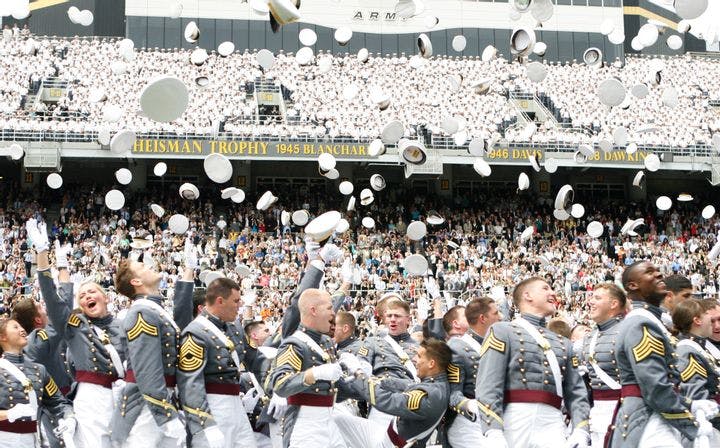Winter 2013
America’s military academies have really changed. Is that a bad thing?
– The Wilson Quarterly
“Gone are the days of ‘shape up or ship out,’” says one concerned observer.
With a few exceptions, the U.S. military academies conduct business much as they did a century ago: Cadets march in lockstep through the quads and shout the menu options at chow. The atmosphere is saturated with reverence for honor and tradition. Bruce Fleming, a professor of English at the U.S. Naval Academy for 25 years, isn’t impressed. The service academies are a “military Disneyland,” he contends, where cadets are coddled and happy pretenses disguise mediocrity and cynicism.
High school seniors who sign up expecting the academies to be “a combination of an Ivy League university and a commando school” quickly discover otherwise. Affirmative action and athletic priorities, among other factors, skew meritocratic admission. A fifth of new midshipmen have to be shipped off to a year of remedial education before they enter Annapolis.
The academies have a few first-class students, Fleming says, but too many have little real interest in their studies. Small wonder, since cadets hardly have skin in the game. Uncle Sam pays the entire bill for every student — they even receive a small salary — about $400,000 per graduate.
Happy PR talk about the “best and brightest” only breeds disrespect for authority. Outstanding students across the academies — Army, Navy, Air Force, and Coast Guard — tell Fleming the same thing: They are “angry, disillusioned, and frustrated.”
Training is compromised, too. “Gone are the days of ‘shape up or ship out.’” Cadets who repeatedly fall short on physical tests do not face expulsion. “Inspections are announced and called off at the last minute, or done sloppily,” Fleming scoffs. “Students aren’t motivated to take care of their own uniforms or abide by the rules because they realize it’s all just for show.”
“The academies are the ultimate nanny state,” he concludes. The “central paradox” is that they draw in alpha types but smother them with mundane regulations on studying, training, and living. “When are they going to let me make some decisions?” a student fumed to Fleming. “The day I graduate?”
Fleming recommends radical changes. After all, Reserve Officer Training Corps programs at universities across the country mint twice as many officers per year as the academies, at a quarter of the cost, and “no data suggest that ROTC officers are of worse quality.” A fundamental problem at the academies is that academics and military training compete for cadets’ attention. Belgium’s undergraduate military academy, where cadets alternate between several months of study and several more of training, may offer a solution. The academies should also relax trivial rules that breed resentment and contempt, as the Royal Military College of Canada has done. They should be less forgiving with wayward students; brighter and fitter candidates can take their places. And they ought to scrap the tradition of military brass serving as presidents. Better to have civilian academics — “ideally women,” Fleming suggests, “because so much of what we do seems to be just the nonsense of older men trying to force younger men to do what they say to get a simulacrum of respect.”
Fleming insists that he makes these observations out of concern, not scorn. “What hurts the most is that the average midshipman has no respect for the institution. I, by contrast, deeply respect its goals — not its lamentable reality.”
The Source: “The Few, the Proud, the Infantilized” by Bruce Fleming. The Chronicle Review, Oct. 8, 2012.
Photo courtesy of The U.S. Army
